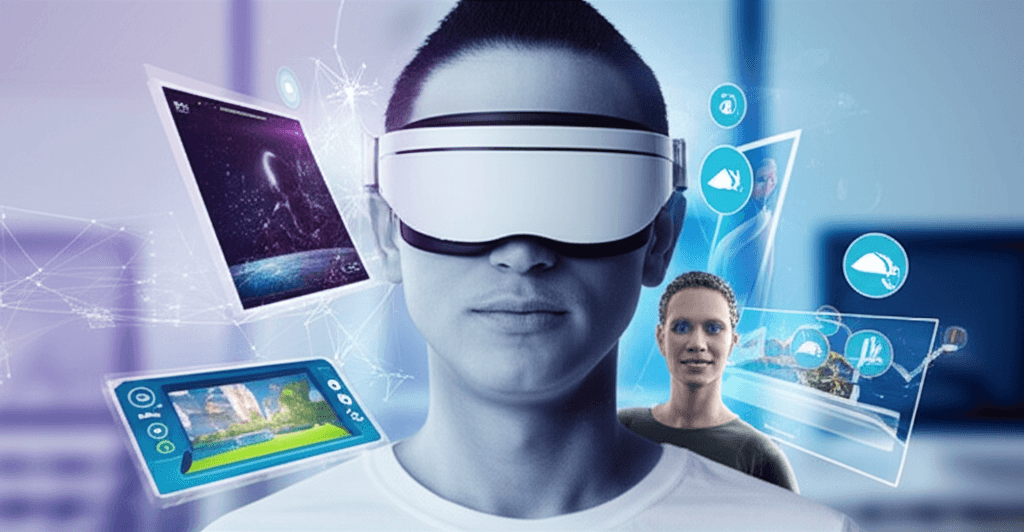Apple's Vision Pro: Generative AI Powers Unprecedented Immersive Spatial Computing
Vision Pro's visionOS 26 update leverages generative AI, transforming digital content into deeply immersive, interactive spatial realities.
June 11, 2025

Apple is significantly advancing the capabilities of its Vision Pro headset by integrating generative AI into its new visionOS 26 operating system, a move poised to deliver more immersive and detailed user experiences across a range of applications. This upgrade focuses on enhancing the depth and dimensionality of everything from photos and games to widgets and online shopping, signaling a deeper commitment by Apple to spatial computing and its potential to reshape how users interact with digital content.[1][2][3][4] The introduction of generative AI is a cornerstone of this update, promising to elevate the headset's functionality beyond its initial offerings and potentially setting new benchmarks within the AI and mixed reality industries.[5][6][7]
A key highlight of visionOS 26 is the introduction of "Spatial Scenes," a feature that leverages generative AI and computational depth to transform standard 2D photos into immersive, multi-perspective environments.[1][2][8] This allows users to lean in and explore different angles within their images, effectively bringing memories to life with a newfound sense of presence.[2][9][10] The AI algorithm essentially "guesses" at details not originally captured by the camera, adding layers of depth and dimensionality that were previously unattainable.[9] This technology isn't limited to personal photos; it extends to Safari, where articles can feature embedded 3D models and spatial scenes that react as users scroll, creating a more engaging reading experience.[1][10] Developers will also gain access to a Spatial Scene API, enabling them to integrate this immersive photo technology into their own applications.[2][8][9] Real-estate marketplace Zillow, for example, is already utilizing this API in its Zillow Immersive app to showcase homes and apartments with enhanced depth and dimension, offering users a more realistic virtual tour.[2][8][9][10] This move underscores Apple's strategy to not only enhance existing media but also to provide tools for developers to build richer spatial experiences.
The integration of generative AI extends beyond static images and into dynamic interactions and applications. Widgets in visionOS 26 become "spatial," meaning they can be placed and persist within the user's environment, reappearing each time the Vision Pro is worn.[1][2][8][3][4] These widgets, which can include clocks, weather updates, music playlists, and photo galleries, are customizable in size, color, and depth, and can integrate with both system and third-party iOS/iPadOS apps via WidgetKit.[1][8][3][11] This allows for a more personalized and persistent spatial computing environment.[3][4] Furthermore, Apple is enhancing Personas, the digital avatars for Vision Pro, using generative AI and machine learning to create more natural and expressive representations.[2][8][11] These updated Personas will feature full side profiles, improved hair and complexion rendering, and more nuanced facial expressions, aiming for a more lifelike interaction in shared virtual spaces.[1][2][8] The setup process for Personas has also been improved, allowing users to preview and adjust their avatars, including choosing from over a thousand virtual eyeglass designs.[1][2] Apple's broader "Apple Intelligence" initiative is also being more deeply integrated into Vision Pro, bringing features like Writing Tools for summarizing and editing text, Image Playground for AI image generation, Genmoji for creating custom emojis, and natural language search in Photos.[12][13][14][15][16][17] Some of these features may leverage cloud processing or even integrate with third-party models like ChatGPT with user permission, indicating a hybrid approach to AI processing.[12][13][16][17]
The implications of these generative AI advancements for the Vision Pro extend into entertainment and productivity. For gaming, visionOS 26 introduces support for PlayStation VR2 Sense controllers, enabling developers to create more engaging experiences with six degrees of motion, finger touch detection, and haptic feedback.[1][2][3][10] This signals Apple's intention to position the Vision Pro as a more serious contender in the immersive gaming market.[1] In terms of media consumption, the update adds native support for 180-degree, 360-degree, and wide field-of-view content from popular camera brands like Insta360, GoPro, and Canon, allowing users to view action footage in its intended immersive format.[1][2][8][3] Safari's spatial browsing capabilities and the ability for web developers to embed 3D models directly into web pages further blur the lines between traditional web content and immersive experiences, which could significantly impact online shopping by allowing users to interact with 3D product models in their own space.[1][8][10][18][19][20] For enterprise users, new APIs are being introduced, including Protected Content for handling sensitive data like medical records, and features like team device sharing to facilitate the management of Vision Pro units within organizations.[1][2][10] Adobe has also announced the integration of its Firefly generative AI and Lightroom photo editing software with Vision Pro, allowing users to create and manipulate images within the mixed reality environment.[21][22]
In conclusion, Apple's infusion of generative AI into the Vision Pro via visionOS 26 marks a significant step in the evolution of spatial computing. By focusing on adding depth, detail, and interactivity to photos, widgets, and applications, Apple is aiming to make the Vision Pro a more versatile and compelling device for both everyday users and professionals.[1][2] The introduction of Spatial Scenes, enhanced Personas, spatial widgets, and expanded support for immersive content and gaming controllers, all underpinned by AI, points to a future where digital and physical realities blend more seamlessly.[2][11][10][4] While the long-term impact will depend on developer adoption and user uptake, this update signals Apple's strong commitment to pushing the boundaries of immersive experiences and solidifies AI's central role in the future of its spatial computing platform, potentially influencing the direction of the broader AI and mixed reality industries.[5][6][7][23]
Sources
[2]
[5]
[6]
[9]
[10]
[11]
[12]
[15]
[16]
[17]
[18]
[19]
[21]
[22]